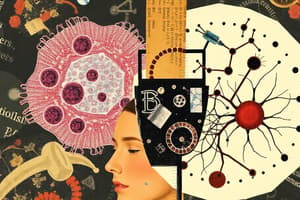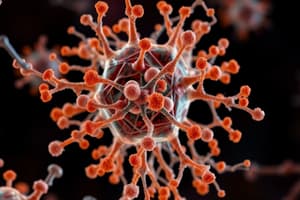Podcast
Questions and Answers
Which of the following best describes the function of lysosomes?
Which of the following best describes the function of lysosomes?
- Synthesis of lipids and proteins
- Breaking down proteins and cellular debris (correct)
- Producing ATP for energy
- Transporting molecules within the cell
What is the primary function of the Golgi apparatus?
What is the primary function of the Golgi apparatus?
- Synthesis of fatty acids
- Storage of genetic material
- Sorting and packaging molecules (correct)
- Generating ATP
Which statement accurately distinguishes prokaryotic cells from eukaryotic cells?
Which statement accurately distinguishes prokaryotic cells from eukaryotic cells?
- Eukaryotic cells have a nucleus while prokaryotic cells do not. (correct)
- Prokaryotic cells have linear DNA while eukaryotic cells have circular DNA.
- Prokaryotic cells possess membrane-bound organelles while eukaryotic cells do not.
- Eukaryotic cells have a peptidoglycan cell wall while prokaryotic cells do not.
Which property of water is essential for maintaining the structural integrity of plants?
Which property of water is essential for maintaining the structural integrity of plants?
What type of bond is primarily responsible for the secondary structure of proteins?
What type of bond is primarily responsible for the secondary structure of proteins?
Which microscopy technique has the highest maximum resolution?
Which microscopy technique has the highest maximum resolution?
What is the role of mRNA in protein synthesis?
What is the role of mRNA in protein synthesis?
What distinguishes saturated fatty acids from unsaturated fatty acids?
What distinguishes saturated fatty acids from unsaturated fatty acids?
Which component of the cell membrane is crucial for its selective permeability?
Which component of the cell membrane is crucial for its selective permeability?
What is the main purpose of meiosis in multicellular organisms?
What is the main purpose of meiosis in multicellular organisms?
Which carbohydrates are considered energy-storing molecules?
Which carbohydrates are considered energy-storing molecules?
What is a significant feature of the structure of DNA?
What is a significant feature of the structure of DNA?
Which factor does NOT affect enzyme activity?
Which factor does NOT affect enzyme activity?
What is the primary function of the rough endoplasmic reticulum?
What is the primary function of the rough endoplasmic reticulum?
Flashcards
Eukaryotic Cells
Eukaryotic Cells
Cells with a nucleus and organelles, including plants and animals.
Nucleus
Nucleus
The organelle that contains genetic material and controls cell activities.
Mitochondria
Mitochondria
Organelles that produce ATP, the energy currency of the cell.
Chloroplasts
Chloroplasts
Signup and view all the flashcards
Cell Membrane
Cell Membrane
Signup and view all the flashcards
Prokaryotic Cells
Prokaryotic Cells
Signup and view all the flashcards
Hydrogen Bond
Hydrogen Bond
Signup and view all the flashcards
Polysaccharides
Polysaccharides
Signup and view all the flashcards
Protein Structure Levels
Protein Structure Levels
Signup and view all the flashcards
ATP
ATP
Signup and view all the flashcards
Transcription
Transcription
Signup and view all the flashcards
Enzymes
Enzymes
Signup and view all the flashcards
Mitosis
Mitosis
Signup and view all the flashcards
Meiosis
Meiosis
Signup and view all the flashcards
Water Properties
Water Properties
Signup and view all the flashcards
Study Notes
Cell Structure & Water
- Eukaryotic cells include animal, plant, and fungal cells
- Prokaryotic cells are simpler than eukaryotic cells
- Water molecules are polar due to the unequal sharing of electrons between the oxygen and hydrogen atoms
- Water is a good solvent, dissolving ionic and polar molecules easily
- Water is important for a variety of biological processes
Carbohydrates, Lipids & Proteins
- Monomers are individual molecules that make up a polymer.
- Polymers are long chains composed of repeating monomers.
- Condensation reactions combine smaller molecules to form larger ones, releasing water
- Hydrolysis reactions break larger molecules into smaller ones, using water
- Carbohydrates include monosaccharides, disaccharides, and polysaccharides
- Lipids include fatty acids, triglycerides, and phospholipids
- Proteins are composed of amino acids, forming dipeptides and polypeptides
Methods of Studying Cells
- Light microscopes have a magnification up to 1500x and resolution of 200nm
- Scanning electron microscopes have a magnification up to 200,000x and a resolution of 20nm
- Transmission electron microscopes have a magnification up to 2,000,000x and resolution of 0.1nm
- Cell fractionation separates organelles from a cell
Nucleic Acids, ATP, Genetic Information, Protein Synthesis & Enzymes
- DNA and RNA are both polynucleotides
- ATP is a molecule that stores and releases energy in cells
- Genetic information is stored in DNA and RNA
- Transcription is the process of producing RNA from DNA
- Translation is the process of producing proteins from RNA
- Enzymes are biological catalysts that speed up reactions by lowering activation energy
- Enzyme activity is affected by factors like temperature, pH, and substrate concentration
Cell Transport & Cell Division
- Cell membranes regulate the passage of substances into and out of cells
- Mitosis is a type of cell division that produces two genetically identical daughter cells
- Meiosis is a type of cell division that produces four genetically diverse daughter cells
Studying That Suits You
Use AI to generate personalized quizzes and flashcards to suit your learning preferences.




